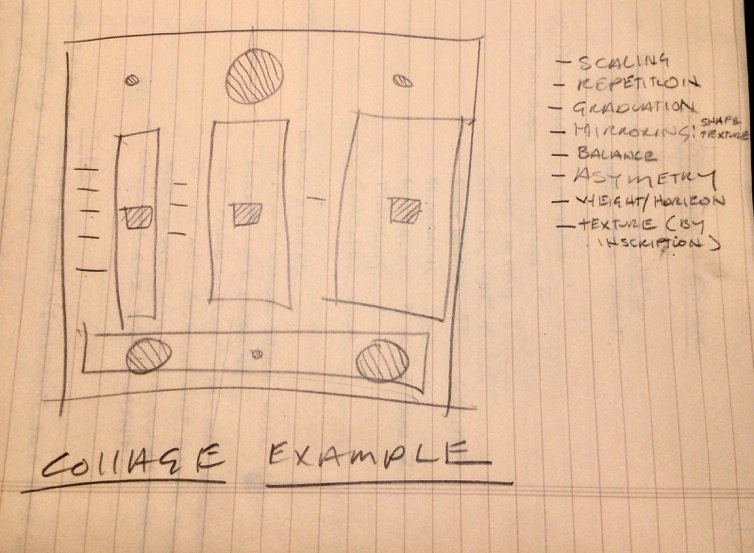Collage Layout
Sketch
Format of Project:
Collage materials glued to an 11" x 17" Bristol backing.
Collage materials may be (almost) anything: newsprint, cardboard, construction paper, staws or coffee stirrers, buttons, photos, gummie bears, string . . .
You may add paint to the collaged items, but this is not a painting.
You may want to do a concept sketch first, as above—or just dive in!
This is not just a personal art project! It is homework to show your understanding of the 2D terminology on your handout. Use as many composition and 2D design concepts as you can. On a separate sheet, write a composition analysis of your own collage. Classical composition constructs may apply, but this is primarily about 2D design. Be clear and precice. Use correct terminology.
Put your name on the project.
Two Dimensional Design Terms
Form:
Geometric Form: Based on mathematical facts about points and lines.
Organic Form: Created by or based upon living organisms.
Random Forms: Created by unconscious human action or incidental influences from nature.
Size: Size is relative to the person perceiving an object or their perspective.
Color: Different wavelengths of light that are reflect or absorbed by an object.
Structure: Placing objects in relation to one another creates structure
Structure Lines: The axes according to which objects are organized.
Concrete Structure: A structure is concrete when the structure lines are visible or actively influence the form of the objects in the structure.
Formal Structure: When objects are evenly distributed in a composition, the structure is formal.
Informal Structure: No regularities in the arrangement of objects in a composition can be discerned.
Graduated Structure: The repetition of the structural elements changes in size or form at an even rate.
Radiated Structure: A formal repetitive structure with structural units that are situated around a common center
Texture: A texture is a structure that can be seen and/ or felt. Texture can be created through inscription and application.
Activities:
Visual reproduction is static. An illusion of activity can be created by implication or sequence.
Repetition: Several objects that share a single characteristic, arranged in a composition, even if other characteristics of the objects are different, creates repetition.Repetition can occur in: FORM, SIZE, COLOR/ VALUE, DIRECTION and TEXTURE
Frequency: The rate and/ or distribution of the repetition.
Even Frequency: When the distance between the repeated objects is identical, the repetition has an even frequency. When it is random, the repetition has an uneven frequency.
Rhythm: When the distance between the objects varies in a pattern between several given frequencies, the repetition has rhythm.
Mirroring: When two objects appear as though they are mirror images of each other.
Rotation: The implied path of an object around an axis or axes (ellipse).
Scaling: When an object is enlarged or scaled down.
Movement: The positioning of an object can suggest forces that have influenced or will influence it and move it.
Path: The imagined line which an object will travel.
Relationships:
Static/ Active: Objects in a group will appear to attract one another or imply movement. A composition which implies no movement is static. A composition that implies movement or attraction is active.
Symmetry/ Asymmetry: When objects are identically arranged on both sides of an axis, they are symmetrical.
Balance: A composition is balanced when all elements have optical equilibrium.
Diffusion: An irregular dispersion of objects in a composition.
Weight: Through conscious use of the upper and lower areas of a format, associations about how we perceive the world can be made, alluding to earth and sky, and give a composition a sense of weight, the illusion of something that flies, or that flows.

